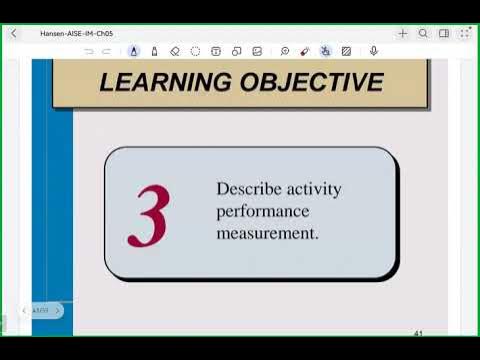Activity Based Management 1
Summary
TLDRThis session covers the concept of Activity-Based Management (ABM) and its relationship with Activity-Based Costing (ABC). ABM is defined as an integrated system that focuses on improving processes to increase customer value and company profits. The presentation explains the two-dimensional model of ABM, which includes cost and process dimensions, and explores how activities impact resources, performance, and decision-making. The relationship between ABM and ABC is discussed, highlighting the importance of accurate cost information in reducing costs and supporting continuous improvement efforts. The session also touches on the implementation challenges and how ABM can be linked to responsibility accounting for better performance management.
Takeaways
- 😀 Activity-Based Management (ABM) focuses on improving processes and activities to increase customer value and profits.
- 😀 Activity-Based Costing (ABC) helps identify costs associated with activities and assigns those costs accurately to guide decision-making.
- 😀 ABM and ABC are complementary: ABM uses ABC data to improve decision-making and reduce costs, driving continuous improvement.
- 😀 One objective of ABM is to improve cost accuracy, preventing over- or under-costing by analyzing cost drivers such as resource usage.
- 😀 ABM uses a two-dimensional model, integrating cost and process dimensions to produce products and serve customers more effectively.
- 😀 Cost drivers are critical in ABM, helping to understand the link between resource usage and activities, which aids in cost management.
- 😀 The relationship between ABM and responsibility accounting is key to measuring performance and assigning accountability to responsibility centers.
- 😀 Process Value Analysis (PVA) within ABM helps assess the value content of activities, identify cost reduction opportunities, and improve efficiency.
- 😀 Measuring and managing activity performance allows organizations to reduce costs and implement continuous improvement measures effectively.
- 😀 A successful ABM implementation requires clear management support, proper training, and resistance management to ensure the system is adopted properly.
- 😀 The ABM model emphasizes using both financial and non-financial performance measures, encouraging holistic decision-making and efficiency improvements.
Q & A
What is the main focus of Activity-Based Management (ABM)?
-Activity-Based Management (ABM) focuses on improving processes and activities to increase value for customers while also improving profitability. It integrates with Activity-Based Costing (ABC) to assess resource usage, activities, and performance.
How are cost dimensions and process dimensions related in ABM?
-In ABM, cost dimensions arise from the use of resources, while process dimensions come from driver analysis, which investigates why an activity occurs, its drivers, and how to measure its performance.
What is the importance of measuring activity performance in ABM?
-Measuring activity performance helps identify cost-saving opportunities, streamline operations, and enable continuous improvement, all of which contribute to reducing costs and increasing profitability.
What role does cost driver analysis play in ABM?
-Cost driver analysis is used to identify and measure the factors that drive costs. For example, in a production process, cost drivers like electricity consumption per unit produced can help accurately assign costs and optimize resource usage.
How does ABM help improve decision-making?
-ABM provides accurate cost information, which is crucial for making informed decisions. By analyzing cost reports, companies can reduce costs, improve efficiency, and support continuous improvement efforts.
What is the relationship between ABM and ABC?
-ABM incorporates ABC by using its cost assignment processes to track costs based on activities. ABC helps identify and allocate resource costs to specific activities, while ABM focuses on improving those activities for better decision-making and cost management.
How does the ABM implementation model work?
-The ABM implementation model involves identifying processes, classifying activities, and conducting value analysis to assess the value of activities. It uses ABC to allocate costs to activities, helping reduce costs and improve profitability.
Why is system planning important in ABM?
-System planning in ABM is essential for assessing the current state of the organization, measuring its competitive position, planning business processes, and ensuring the availability of resources for implementing improvements.
What is the significance of responsibility accounting in ABM?
-Responsibility accounting is fundamental in ABM because it ensures that managers are held accountable for activities within their responsibility centers. It allows for performance evaluation, benchmarking, and rewards based on activity outcomes.
What are the common challenges in implementing ABM?
-Common challenges in implementing ABM include lack of support from top management, resistance to change, insufficient training, failure to integrate new systems, and unmet expectations regarding results.
Outlines

هذا القسم متوفر فقط للمشتركين. يرجى الترقية للوصول إلى هذه الميزة.
قم بالترقية الآنMindmap

هذا القسم متوفر فقط للمشتركين. يرجى الترقية للوصول إلى هذه الميزة.
قم بالترقية الآنKeywords

هذا القسم متوفر فقط للمشتركين. يرجى الترقية للوصول إلى هذه الميزة.
قم بالترقية الآنHighlights

هذا القسم متوفر فقط للمشتركين. يرجى الترقية للوصول إلى هذه الميزة.
قم بالترقية الآنTranscripts

هذا القسم متوفر فقط للمشتركين. يرجى الترقية للوصول إلى هذه الميزة.
قم بالترقية الآن5.0 / 5 (0 votes)






